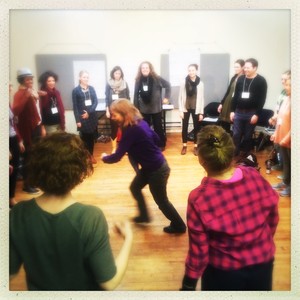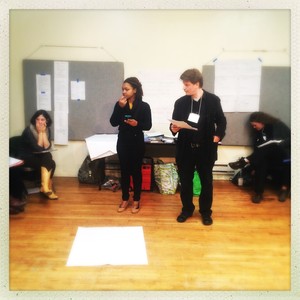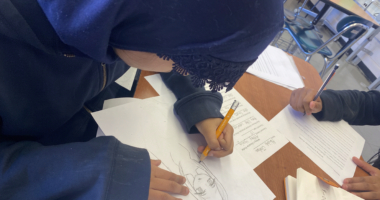The fourth installment of the TATIP Saturday Workshops was held on November 21st at Studios 353 in midtown, and what a day we had! The workshop was specifically for the New & Beginning trainees, so that they could present their lesson plans, but many of our Advanced trainees came to see what they came up with. Stepping in for Renée Watson this week was CWP Deputy Director of Programs & Operations, Megan Morrison, who helped TATIP facilitator Patti Chilsen give thoughtful feedback to the trainees about their presentations. We opened the day with Megan leading us through a stretching warmup to focus the participants and give them a chance to become familiar with her in the group.


Up first, Janet Onyenucheya and Krystalla Pearce presented their lesson, which involved using call & response, rhythm and movement to explore elements of the Afro-Brazilian performance style “Maracatu”. They brought in pictures as evidence or “contextual information” of the style, dress, and instruments – a very strong teaching tool! In an activity they called “Maraca Who?”, they introduced the students to the style of maracatu and explored the traits people heard in the music selection they played. They then split the group up in order for them to create a simple two-part drum pattern. It was a very lively lesson that had the participants on their feet and engaged.


Next, Liana Harper-Cruz and Audin Hargrove had a specific objective in mind when they designed their lesson: How do we use the idea of freedom and visualization to create a short essay and empower the students? They led the group through a series of journal exercises, which they compared the results with other participants’ writings. They put a unique spin on the closing ritual and had students do a call & response in time with a drum beat Liana gave us, all the while repeating the words “I am Unique. I am Talented. I am Precious. I am Important. I am Powerful.”


Dale Novella Anderson and Gary Devirgilio were up third and mixed things up by bringing creative writing and filmmaking together for a lesson designed for 9th graders. They started off with a guided free write and asked the students to think about their first day of school when they were younger. While initially hesitant, the participants became excited about sharing their first experiences and comparing the good and the bad.

Dale and Gary then took us through a brief screenwriting lesson, using the film Little Miss Sunshine as an example, and had the group break their free-writes down into three layers: a beginning, middle and an end. By the end of the lesson, we each had a brief outline for a short film project.

Next up, Jacqueline Raymond and Eli Pauley led us in a lesson designed for 2nd graders.

They did not shy away from a tough topic, but created a way to engage with important social justice material in a way that 2nd graders could access. They compared a recording of the real Martin Luther King, Jr. with that of the actor who played him in the film Selma, a film about his life. They asked students to notice what changed in his voice, was the accent different, did he sound more lively, happy or sad?

Rachel Alulis and Shawn Ferreyra led us through an exciting lesson on color in storytelling for 3rd graders. They started by passing out different images and asked the students to arrange themselves in order – whatever order they felt. The participants did, only to discover that they had been arranging themselves by color.

Rachel and Shawn combined their expertise from two different art forms (lighting and visual arts) and then introduced them to a lesson on “color scripts”, using various images from the movie Frozen to illustrate their points. Depending on the characters’ moods and the action in the story, the colors would change to reflect what was going on.

Just before lunch, Jehan Roberson and Alex Velozo took us through a lesson on composition and pattern for 1st graders. They used sketch journals and Alice Walker’s “I Will Keep Broken Things” to illustrate both elements in visual art and in writing. It was a blend between the two art forms, using them to enhance the experience for the participants. For the final activity, they placed a piece of red yarn on the floor and had participants put different circles, square, triangles and rhombus shapes with words from the poem along the red yarn in random order. This was a simple and clear way to illustrate repetition, line breaks, and revising the order of words to create new poems.


After lunch, Patti led us through a physical warm up to shake off the midday lunch sleepiness and then handed the floor over to Emily Collins and Kelsey Piva, who led the participants in an activity that turned their shared emotions and traits into a list of similes. They played the song “Everything at Once” by Australian pop artist Lenka and asked the participants to name the similes in the song. From there, the participants were given the opportunity to create similes based on their own emotions and share them with the rest of the group.


Rachel Elfezouaty and Mariella Suarez presented a visual arts and writing lesson for 1st graders that focused on the Futurism movement. After a brief warm up to get the participants ready, Mariella and Rachel used the artist Marcel Duchamp to introduce the participants to the movement.

Then, they had everyone create their own characters using finger puppets highlighting some unique quality of their own to make them really come to life. They allowed the students a significant amount of time to create their finger puppets, and then the lesson ended with a puppet parade where everyone was able to show off their creation and explore how to show movement of their puppet character.


Our final team for the day, Deanna Green and Alessandra Salvemini, focused their lesson for 1st & 2nd graders on teamwork. They modeled teamwork in their presentation, sharing the hello introduction and co-reading the teamwork story about fishing with dolphins (a fascinating new topic). Also provided were images and storybooks of teamwork as examples for the small groups to process. They split the room into four groups and had each group create a visual representation of teamwork using various art supplies. They shared the story about fishing with dolphins and unpacked it by identifying the elements of teamwork that could be found in the story. In the group exercise mentioned above, groups were given images for inspiration.


After the lessons were over, Patti and Megan led the group in a debrief about the day and talked openly about working with a partner to facilitate a lesson. It was a very exciting and engaging day, and our trainees have certainly earned a Thanksgiving break after all of the wonderful presentations they put together. When we return on December 5th, our final two teams will present their lessons and we will discuss the successes and challenges of classroom management. We’ll see you then!




